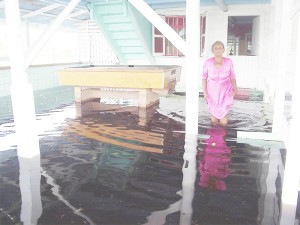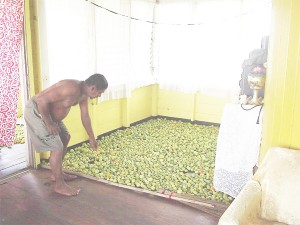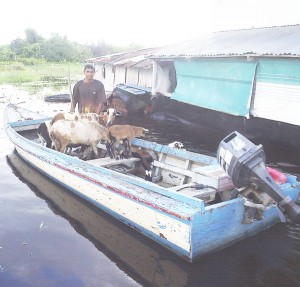Once teeming green fields, filled with produce, some of which was almost ready for reaping have merged with the Mahaica Creek as farmers remain under high floodwaters a week later.

Earlier last month, they had fought to save their crops from rising levels in the Creek in an ultimately futile battle but the water eventually flooded the land on Christmas Day and rapidly rose. The opening of the Maduni Sluice by the authorities last week to drain the East Demerara Water Conservancy is what the residents blame as the main cause of the flooding and they were harsh in their criticism of officialdom, which they feel, has not been honest with them.

They said that even the heavy rainfall could not have flooded the land to the extent that it has been and according to them, it is just about six inches below the highest floodwater they had ever experienced, which was in 2006. Feeling hopeless, but with the majority have living their lives knowing nothing but the land, their instinct is to return to it once the floodwater recedes but they are adamant that they would need some assistance and compensation, as they point out that the flooding could not have been caused by the rain alone and had officials been honest with them in relation to the opening of the Maduni sluice, they could have taken some action to ensure that their losses were not so severe.

In recent days, even though there was no rain, the water rose though for the past two days it has remained constant, residents said. Following the 2006 flooding, they had been granted the use of excavators to raise plots and empolder, which they did, but the current floodwater is level with the raised land, the residents related to this newspaper during a visit to several villages on the banks of the Mahaica Creek yesterday. Their farms and homes are under several feet of water and livestock have died. Getting to their home is easy; just paddle the boat up to the front step and hop out.
“No rain nah fall for a couple ah days and the water still rising” said farmer Elvis Hussain who was forced to reap tomatoes that were still green. He said though, that they would not ripen and he would be unable to sell them. Looking over the large quantity of small, green tomatoes which were placed on various flat surfaces of his home at Little Baiboo, he stated that in normal circumstances he would have reaped at least 5000 pounds of the fruit which would have sold for about $80 per pound on average. But that was not all he lost. His fields of bora, corilla, squash and plantain have been overrun by the floodwaters as have many belonging to other farmers. Like them, he would like some assistance to be extended to them but is not too optimistic. “Them does promise but you nah get nothing”, he declared.
Standing in the watery area that is the ground portion of her Little Baiboo home, Bhagwantie Ramjattan “feeds” her three lambs via a nursing bottle that contains water, since she has nothing else to give them. Three of her sheep have died as had 17 of her 18 chickens and 3000 roots of bora, 2000 roots of watermelon and other crops. She worries about the safety of her children in the floodwaters. “It already hard” she said stating that the only assistance that she has received so far is a bag of bran to feed the sheep from a resident in the area.
Several of Rookmin Persaud’s grandchildren had fallen sick and had been sent to stay with relatives. “Nobody nah come to offer we assistance” said the 70-year-old woman. Over at Big Baiboo, Omawattie Nagasar lists her losses: 2500 roots of bora, 700 tomato plants and 250 pepper plants. She said if the floodwaters were to recede now, it would take at least four months before the farmers can reap from new crops. She said that she hoped that some sort of assistance would be offered by the government.
For a group of farmers at Big Baiboo, compensation is a burning issue. They took offence at suggestions that they “like” to ask for compensation, as they discussed a visit by Agriculture Minister Robert Persaud on Monday. They said that Persaud didn’t say “much” and they appealed for President Bharrat Jagdeo to visit.
The opening of the Maduni Sluice is a topic that draws anger as they say that it is an ongoing action and referring to a visit to the sluice, where they had filmed it while it was opened and no word had been communicated to them beforehand; they say they now have proof. “Nobody nah beg for nothing, rainfall never flood here…people nah got to beg for nothing if they nah get flood”, said one man.
Pooran Ramai, 62, has lost several acres of cash crops. “The main thing is how people gon live from now till they go back to the land”, said Parsram Heera. They related that during Persaud’s visit, he had said that they would not be given any foodstuff but some fertilizer and seeds to go back to the land.
Many residents of Big Baiboo plant on a large scale and have lost everything. Their list is long and like their fellow farmers they blame the flooding on the opening of the Maduni sluice and say that they are entitled to compensation. At Grass Hook, retired schoolteacher Rohani Gopaul, 63, and her husband, farmer Cyril Gopaul, 72, have lost their crops and express worry about drinking water, since they say that the Creek is contaminated. They catch rainwater to drink. Spry Rohani said that they were doing fine but “just as (we) reach the peak, everything gone”. At Grass Hook too, Marcellous Sarjoo lost two and a half acres of watermelon, tomatoes, cucumbers, pak choy, and bolangers. He said that they were independent people but at times such as now, they need help.
Sugrim Sarju, also of Grass Hook, like many others along the river, can use his boat to get to his doorstep. He declared that the farmers need compensation.
Back in Big Baiboo, Hero Heeralall’s field filled with bora, unripe peppers and tomatoes has been inundated and the green fruits rot in the water. As he transported his sheep in his boat over the floodwaters to their pen, he is maybe looked upon as a hero by the sheep for doing so but that feeling is almost certainly going to change. One lamb died in the field yesterday and Heeralall said that he is going to sell them before they get any thinner. He has good reason to do so. In the high waters of the Mahaica Creek, this newspaper had spotted the carcass of a drowned goat. Other farmers have reported that their livestock have also died. In their flooded yards and fields, they worry over their next steps. The water on the land remains high. On almost everyone’s mind is a question. What next?







